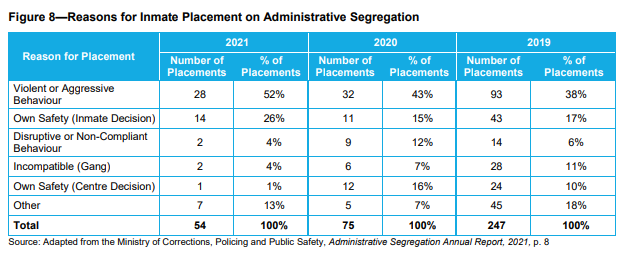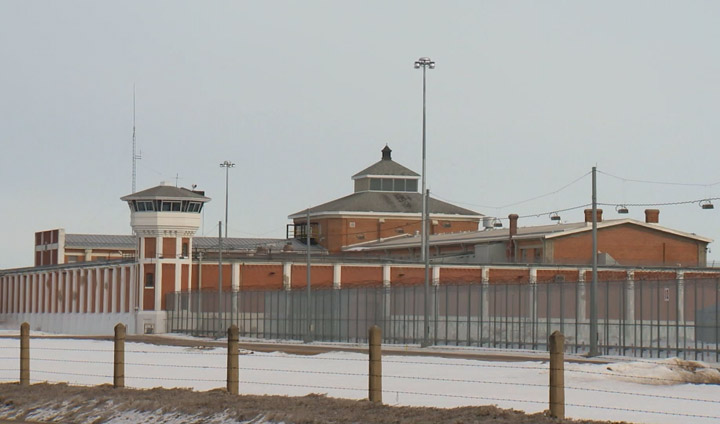A report done by Saskatchewan’s provincial auditor saw the need to give recommendations to the Ministry of Corrections, Policing and Public Safety after an audit pointed out the inconsistency around inmate administrative segregation.

The report, which was released on Tuesday, says administrative segregation is used at correctional facilities to keep inmates away from the general population for safety or security purposes, noting that inmates should not be segregated for longer than 15 days.
An audit done between January 2021 and April 2022 found 13 inmates that had been in administrative segregation for longer than 15 days, with the longest being recorded at 43 days.

“Unnecessary or prolonged segregation may leave vulnerable inmates with irreparable mental and physical health damage that may lead to higher healthcare costs (e.g., self-harm injuries) and, in extreme cases, to avoidable life loss (e.g., suicide),” the report read.
It added that in 2021, there were 54 placements of 49 inmates on administrative segregation. There were 75 placements in 2020.
Recommendations for the Ministry included developing a training plan for correctional staff involved in administrative segregation; having appropriate staff authorize administrative segregation decisions as well as properly completing reviews and assessments; broadening the quality assurance reviews; and enhancing written reports to senior management.
The report looked over Saskatchewan’s four adult secure-custody correctional centres:
- Prince Albert Correctional Centre
- Regina Correctional Centre
- Saskatoon Correctional Centre
- Pine Grove Correctional Centre
- Posters promoting ‘Steal From Loblaws Day’ are circulating. How did we get here?
- Video shows Ontario police sharing Trudeau’s location with protester, investigation launched
- Canadian food banks are on the brink: ‘This is not a sustainable situation’
- Solar eclipse eye damage: More than 160 cases reported in Ontario, Quebec
According to the annual report for the Ministry in 2021-22, it spent $171 million on custody services.
The Ministry added that it had more than 1,800 inmates, with 44 per cent of them being sentenced and 56 per cent on remand.
The Custody Services Unit had 1,873 full-time equivalent staff as of the end of March 2022.
The auditor’s report noted that inmates could be placed on administrative segregation for things like aggressive or violent behaviour, non-compliant or disruptive behaviour, or at the request of an inmate for their own safety.

It noted that 20 inmate files on administrative segregation were reviewed in 2021, with three assessments being completed by inappropriate staff, and one assessment not documenting the reason for administrative segregation or the alternatives considered.
The report noted that five of the inmate placements were not properly authorized, with all five cases being approved by a correctional officer instead of a correctional centre manager.
“Not having appropriate staff completing and approving administrative segregation placement decisions increases the risk that inmates may be placed on administrative segregation inappropriately,” the report read.
Other paperwork and communications, like signoffs that an inmate was verbally informed that they’d be placed in administrative segregation, reviews of administrative segregation, as well as health-care assessments, weren’t always completed, according to the report.
Recommendations around health-care assessments related to the completion of assessments and training for nurses on staff.
The report said 20 inmate files were tested and found that some health-care assessments weren’t completed, or they were done three to seven days after the fact.
It noted that some nurses were interviewed and found that there was a lack of understanding of when a health-care assessment was needed, with some nurses citing a review that no longer exists.
The report said nurses do not receive refresher training on administrative segregation processes.
The Ministry of Corrections requires correctional staff to meet with inmates daily and record the results of the meeting in the IT system. According to the report, this is inconsistent, with one example given of an inmate being placed in administrative segregation for 24 days, but only eight daily reviews were recorded.
Other provinces like Ontario give public information on their website regarding administrative segregation, like the number of placements, the length of the stay, as well as some demographic information. The auditor’s report suggests that the Ministry should start doing this.
“Publicly reporting information about the use of administrative segregation would help the Ministry demonstrate its commitment to reducing the over-use of segregation, enhance accountability, and encourage oversight,” the report read.







Comments